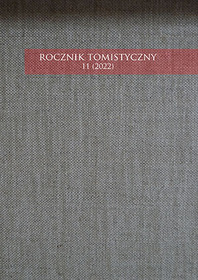Franciszek von Tessen-Węsierski (1869–1947) i jego tomistyczna teorii cudu
Francis von Tessen-Węsierski (1869- 1947) and His Thomistic Theory of Miracle
Author(s): Artur AndrzejukSubject(s): Philosophy, History of Philosophy, Special Branches of Philosophy, 19th Century Philosophy, Philosophy of Religion
Published by: Naukowe Towarzystwo Tomistyczne
Keywords: Francis von Tessen-Węsierski; Thomas Aquinas; theory of miracle; philosophy; apologetics
Summary/Abstract: Francis von Tessen-Węsierski was born on 22nd December in 1869. He came from the old noble Kashubian family who settled in the Eastern Pomerania (mainly in the area of Słupsk), in the Front Pomerania and in Ruggia. Francis’ father, Joseph, studied in Berlin where he later took up. In Berlin Francis completed his Matura (23rd March 1890) and after that he studied at the Theological Faculty of the University of Wrocław. He finished his Bachelor’s degree in 1894 and at the same year was ordained a priest. In the next year he earned a Habilitation and became a so called private docent (Privatdozent). Initially he taught the history of the Church and philosophy and also apologetics since 1897. In 1899 he was nominated an assistant professor of apologetics, next, in 1900 he was appointed a lecturer in pro-pedeutics of philosophy and apologetics; on 15 March the same year he obtained a Doctorate for the entirety of the academic work. In the same year he was offered to take the chair of the Dogmatics at the Theological Faculty of the Jagiellonian University. However, the prince-bishop, cardinal Jan Puzyna denied a canonical mission to Tessen- Węsierski on the basis of the insufficient knowledge of the Polish language by the candidate. Thus von Tessen-Węsierski stayed at the Theological Faculty of the University of Wrocław as an assistant professor, a lecturer of apologetics and propedeutics of philosophy. In 1933 when Adolf Hitler gained the power in Germany von Tessen-Węsierski was dismissed from the faculty for the lack of his “racial purity”. As a pensioner he lived in Szczecin. Nothing is known about his life during the war, nevertheless, it was noted that when the city was incorporated to Poland he was the first priest of Polish origin who stayed in Szczecin, and he died there on 7th January 1947. Theory of miracle is formulated by Tessen-Węsierski within the frame of apologetics, which is a theological discipline, however with regard to its goal-defense of religion- it significantly relies on philosophical argumentation in the process of explaining rationality of religion and related facts. Path to explanation of the phenomenon of miracle is- as Tessen- Węsierski claims- a carefully prepared definition. He starts his work from the cognitive and subjective analysis of miracle, what he calls a psychology of miracle. We may speak of miracle when something, some event or phenomenon, makes an impression on an observer. Source of that impression is comparison of that phenomenon to non-miracle facts. In the consequence it arises the need for explaining the cause of miracles. Following St. Thomas Aquinas Tessen- Węsierski links the phenomenon of miracle with astonishment (admiration). It- astonishment- takes place when we recognize the conditions (causes) and circumstances and we expect results which supposed to be derived from the given conditions and circumstances. But what happens is entirely different. It must have appeared the unknown cause (causa oculta), which influenced that usual natural process (result). Epistemological and psychological aspect of miracle leads us to metaphysics (ontology) of miracle, because finally it comes down to inquiry (inquisitio) on what caused the fact astonishing to us. In this point we need to turn to God’s Revelation, for only in its light we are able to explain that what transcends our nature. Theological competency is hence needed to cross from the negati-ve criterion: result could not have appeared if had been caused by the natural cause, to the statement that the result has its supernatural source. Tessen-Węsierski says that the proper perspective for that what is supernatural (Übernatürlichen/ supernaturale), is that what is natural. He reminds that Thomas Aquinas claims that in case of miraculous phenomena we deal with four factors: 1) intervention of God, 2) trespassing the natural order of things and 3) the result that differs from hitherto. Thus the main issue becomes the problem of God who is the principle of both: of that what is natural, as the Creator of beings, and of that what is supernatural when God exceeds with His power (Kraft) the order indicated by the act of creation. In solving this problem Tessen-Węsierski introduces a demarcation line between the nature and supernaturality. Thus, according to him, natural is that what derives from the God’s act of creation and that what is a certain order of existence and a mode of functioning of created beings. Supernatural is hence that what derives from God but exceeds the natural order of created things. Accordingly, the greatest supernatural thing takes place when human nature is adopted into the unity of the Divine Person in Jesus Christ, the unity called the hypostatic union. Further great “supernatural thing” (der supranaturalen Dinge) is vocation of man to cognize the Divine Essence and in general to community with God. What serves this purpose is grace and everything what accompanies (for example sacraments), and that is what constitutes further “supernatural thing”. Finally, supernatural fact is present in concrete, individual activity of God in some individual case. The latter one includes miracles- the subject of our interest- and private revelations.
Journal: Rocznik Tomistyczny
- Issue Year: 2022
- Issue No: 11
- Page Range: 261-276
- Page Count: 16
- Language: Polish

